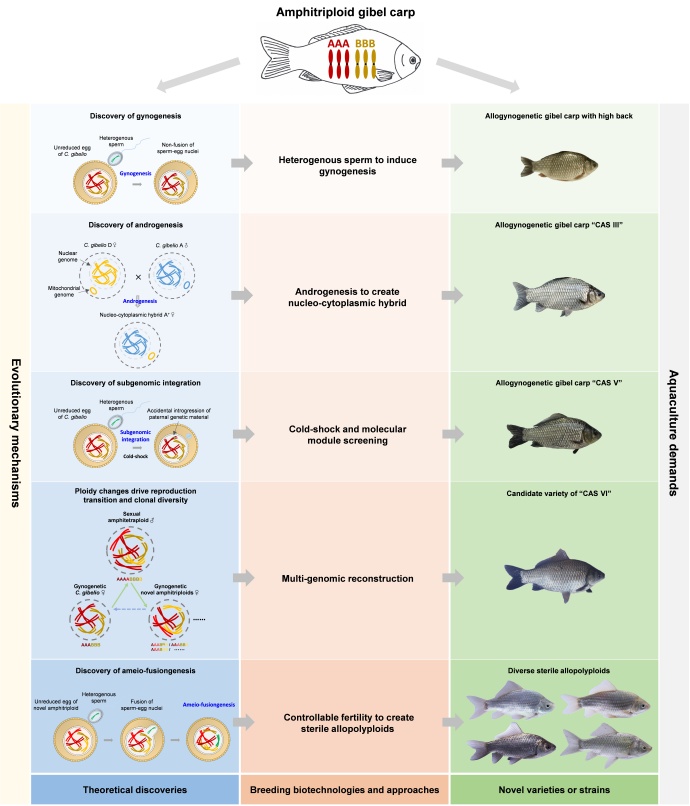Highlights
Chinese Wisdom and Modern Innovation of Aquaculture
Aquaculture originates from ancient Chinese wisdom, and is considered the most efficient food-producing industry.About 70 years ago, New China proposed an industrial approach to fish production and made a policy decision to begin modern aquaculture development . As one of lucky persons since the early 1980s, Prof. Gui Jian-Fang from the Institute of Hydrobiology (IHB) of the Chinese Academy of Sciences have committed his scholarly career to the studies on genetics and breeding biotechnology of polyploid gibel carp (Carassius gibelio), and witnessed significant innovations in aquaculture.
Recently, Prof. Gui outline the historical development of traditional aquaculture and decision-making of modern aquaculture especially in precise genetic breeding. Some modern innovations and contributions are also highlighted in other aspects of aquaculture. This study was published in the KeAi journal Water Biology and Security.
In this study, several significant recent innovations, such as the proposition of the amphitriploid concept (Wang et al.,2022), the association of ploidy changes with reproduction transition (Lu et al.,2022), the finding of a unique ameio-fusiongenesis mode (Lu et al.,2023), the establishment of a controllable fertility approach (Lu et al.,2024), the creation of intermuscular bone-free mutants (Gan et al.,2023), as well as the recreation of desirable goldfish (Yu et al.,2021 & 2022), are introduced and emphasized from an active participant of these innovations. Additionally, some modern innovations and contributions are also highlighted in other aspects of aquaculture including feed development, disease control, facilities and equipment upgrading, as well as paradigm and mode changes. This comprehensive synthesis of ancient Chinese wisdom and modern innovations seeks to provide valuable insights into the field from a historical basis.
In the last section, Prof. Gui also proposed ten paradigm changes and future directions in sustainable aquaculture, which exposed a blueprint for global aquaculture development.
(1) More emphasis on genetically improved varieties and good native stock species to reduce dependence on general wild species and alien species;
(2) Developing controllable fertility biotechnology to breed sterile aquaculture varieties to avoid genetic pollution/dilution of wild stocks and disease spread by escaped aquaculture varieties;
(3) Optimizing polyculture and multi-trophic aquaculture to enhance yield and quality;
(4) Activating rice-field aquaculture, the globally important agricultural heritage systems, to develop eco-agriculture, which would not only produce more rice and aquatic food, but also revitalize rural beauty;
(5) Exploiting recirculating water facilities and intelligence techniques to develop smart aquaculture and eco-engineered aquaculture, which will have the ability to solve labor inequities in current aquaculture, especially for women;
(6) Utilizing filter-feeding fishes for purifying water quality to develop eco-fisheries in large water bodies of lakes and reservoirs;
(7) rohibiting fertilizer use to maintain chemical-free aquaculture and clear water environments;
(8) Introducing stringent nutrient and feed standards to improve aquatic product quality consistency;
(9) Strictly controlling tailwater discharge to avoid eutrophication of natural waters and toxic cyanobacteria blooms, thereby improving environmental health;
(10) Justifying aquaculture space needs to ensure balance of aquatic product outputs.
At the same time, Prof. Gui analysis the plan "10-year ban on fishing in the Yangtze River", which create a precedent from "capture" to "aquaculture" and then to "protection". He believes that this should be a new contribution of Chinese wisdom to the world.

Multifaceted amphitriploid gibel carp and its significant applications
(Editor. WANG Hongxia)